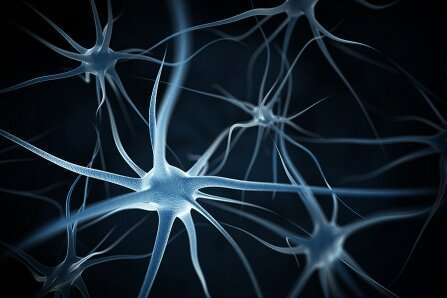Researchers have identified the first human-specific fusion gene

University at Buffalo researchers have identified the first human-specific fusion gene—a hybrid of two genes—implicated in Alzheimer's disease. The finding suggests that a neurotransmitter receptor, previously successful in animal studies but that failed in human trials for Alzheimer's, might still turn out to be a valuable therapy.
In a paper published in February in Translational Psychiatry, the UB researchers reported that this human fusion gene acts on a receptor for the neurotransmitter acetylcholine, which is involved in memory and learning, and which is reduced in people with Alzheimer's.
The fusion gene is CHRFAM7A, which is very common in people and has been implicated in many neuropsychiatric disorders, such as schizophrenia and bipolar disease.
"This fusion gene plays a very interesting role in Alzheimer's disease," said Kinga Szigeti, MD, Ph.D., senior author, director of UB's Alzheimer's Disease and Memory Disorders Center, part of UBMD Neurology, and associate professor of neurology in the Jacobs School of Medicine and Biomedical Sciences at UB.
She explained that it is a fusion between a gene coding the alpha 7 nicotinic acetylcholine receptor, which has been a promising but ultimately unsuccessful target for Alzheimer's, and a kinase, a type of enzyme.
"Alpha 7 has long been associated with Alzheimer's," said Szigeti, "but several alpha 7 medications have worked in animal models and failed in human studies. Perhaps this fusion gene is the reason for the translational gap."
The scientists noted that their findings suggest that a more personalized approach to each patient may be required, based on their CHRFAM7A genotype.
To do the study, the UB researchers had two Alzheimer's patients donate a small piece of skin. The skin samples were transformed back into induced pluripotent stem cells, which can then be differentiated into neurons. They used the stem cell lines to develop an in vitro model system to study how this fusion gene modifies neurons in Alzheimer's.

"We found that this human fusion gene functions to modulate the alpha 7 receptor, which is one of the receptors that amyloid beta acts on," Szigeti explained.
A neuronal cry for help
"The gene activates neuronal interleukin 1B, which regulates immunity and inflammation, as a kind of neuronal cry for help," she said. "By interfering with the uptake of the amyloid beta proteins and by activating interleukin 1B, this gene makes neurons more resistant to amyloid, thus protecting against the amyloid buildup, which is the hallmark of Alzheimer's disease."
The research has revealed the possibility that preventing or treating the disease may depend on a two-pronged approach, Szigeti said.
"I think that Alzheimer's happens when amyloid beta is increasing, but for each person the neurotoxic level of amyloid depends on the health and resistance of their neurons. To treat Alzheimer's disease, we will need to target both: to decrease amyloid—which is the goal of most therapies—and at the same time to increase the resistance of neurons."
The UB researchers are now exploring collaborations to re-analyze clinical trials targeting the alpha 7 receptor, based on the absence or presence of this fusion gene. Szigeti said that it is possible that past clinical trials may have been unsuccessful because the patients were grouped together whether they had CHRFAM7A or not. The drugs may have worked in one of the groups.
Personalized approach may succeed
"So it seems that if we try to use the same drug for everyone, we may not detect an effect," she said. "A more personalized approach for each patient may be more likely to succeed.
"Our next step is to elucidate the exact mechanism for how amyloid affects the cells when this gene is present or absent," said Szigeti. "We would also like to test our hypothesis that the presence of this fusion gene protects the neurons in the clinical setting by comparing progression rates in the groups through collaborations with longitudinal cohort studies."
More information: Ivanna Ihnatovych et al. iPSC model of CHRFAM7A effect on α7 nicotinic acetylcholine receptor function in the human context, Translational Psychiatry (2019). DOI: 10.1038/s41398-019-0375-z


















